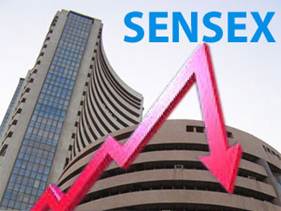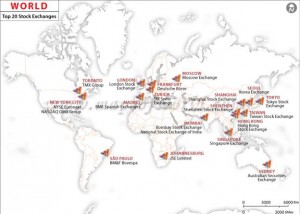Disclaimer: This Blog,its owner,creator & contributor is neither a research analyst nor an Investment Advisor and expressing opinion only as an Investor in Indian equities.He/She is not responsible for any loss arising out of any information,post or opinion appearing on this blog.Investors are advised to do own due diligence and/or consult financial consultant before acting on any such information.Author of this blog not providing any paid service and not sending bulk mails/SMS to anyone.
Friday, 29 July 2016
Friday, 22 July 2016
10 INTERESTING FACTS YOU MAY NOT KNOW ABOUT INDIAN STOCK MARKETS
- There are 12 stock exchanges in India. Out of which only 7 are permanent and rest 5 require their license to be renewed timely. 13 other exchanges have already been granted exit by SEBI. Can you recall any names apart from NSE and BSE?
- The record low Sensex has ever touched is 113.28 points in December, 1979 and after 35 years; it touched the record high at 30024.74 in March, 2015.
- Do you know U.S markets (S&P500 & Dow Jones Industrial Average) and UK’s FTESE100 contracts can be traded in NSE? It was for the first time, S&P500 were listed on any exchange outside U.S.A
- BSE is one of world’s top exchanges in terms of listed members. It has more than 5,000 companies on the list.
- Did you that on Nov, 2014 India became one of top 10 markets in the world by market capitalization? India market capitalization is approx. $1.6 trillion & it is ahead of Switzerland & Australia markets based on Market Cap.
- Only 2% of Indian household savings are being directed to Equity markets, Indians are so risk-averse!
- Foreign Institutional Investors (FIIs) are the strongest driving force in Indian markets. Among Domestic Institutional Investors (DIIs), LIC leads the way.
- The NSE has the second largest volumes in the derivatives market. It ranks second in Index Options, and third when it comes to the Stock Index Futures.
- The total F&O traded value on 30th April, 2015 stood at Rs 6.27 lakh crore, registering a jump of nearly 8 per cent over its earlier high of Rs 5.81 lakh crore recorded on February 26, 2015.
Friday, 8 July 2016
An Indian farmer’s son is now worth more than $300 million after his health care firm’s IPO

By his own admission Arokiaswamy Velumani was born at the bottom of the pyramid
The son of a landless farmer from the nondescript village of Appanickenpatti Padur in Tamil Nadu, Velumani saw through school and college on subsidised funding from the government.
“My parents were very poor,” Velumani said. “They never had the luxury of buying me a pair of chappals (sandals) or trousers. I was born at the bottom of the ten slices of the pyramid. It wasn’t easy. But today, I am at the top of the very pyramid.”
Thyrocare, the company Velumani founded two decades ago, made its debut on Indian bourses, with a valuation of Rs3,377 crore ($505 million), as on May 13. Velumani owns a 64% stake in the company. That makes him worth at least $323 million.
Thyrocare claims to be the world’s largest thyroid testing company, with a network of 1,122 outlets across India, Nepal, Bangladesh, and the Middle East. It also runs one of India’s largest network of health diagnostic labs, processing over nine million samples and conducting over 30 million medical tests every year.
From scientist to entrepreneur
Velumani’s career began with a job as a shift chemist at Gemini Capsules, a small pharmaceutical company in Coimbatore, in 1979. The 20-year-old chemistry graduate earned a paltry Rs150 ($2.25 currently) every month. Three years later, the company shut down and Velumani suddenly found himself without a job.
“That was a blessing in disguise,” he said. “Only when you are pushed hard or thrown out, you want to achieve more.”
Velumani applied to the Bhabha Atomic Research Centre (BARC), one of India’s finest atomic research centres in Mumbai, for the job of a lab assistant. He was accepted. But once inside the prestigious centre—named after Homi J Bhabha, the founder of India’s nuclear energy program—Velumani decided to study further.
He began with a master’s degree in 1985 and eventually completed his doctoral program in thyroid biochemistry by 1995, through a tie-up program that the University of Mumbai had with BARC. “Those days, I was earning and learning,” recalled Velumani, “BARC allowed scientists to study and research further.”
“In 1982, I did not know where the thyroid gland was,” he admitted. “By 1995, I was a PhD in thyroid biochemistry.”
In the meantime, he also rose to the rank of a scientist and was posted at the Radiation Medicine Centre (RMC), a BARC department that focused on the application of nuclear energy in healthcare and agriculture.
But some 14 years after he started work at BARC, Velumani put in his papers. He had decided that he wanted to use his expertise in thyroid biochemistry to set up testing labs to detect thyroid disorders. With the Rs100,000 ($1,500) that he collected through his provident fund, Velumani set up shop in Byculla, a middle-class neighbourhood in South Mumbai, which is a short distance from the Tata Memorial Hospital, a prominent cancer institute. He was 37-years-old then.
Velumani’s wife, who died in February this year, due to pancreatic cancer, quit her job at the State Bank of India to become his first employee. “As with any business, the initial years were difficult,” said Velumani. “But when you are passionate about something, those pains also become a pleasure.”
Thyrocare’s business model
India has a massive thyroid disorder problem.
One in every 10 person in the country suffers from hypothyroidism; women are especially vulnerable. But the detection rate of the condition remains abysmally low, even though the condition results in preterm births, intrauterine growth restriction, respiratory distress and increased perinatal mortality in pregnant women.
With an eye on the huge potential for thyroid testing, Velumani started out with a franchise model where samples would be collected across the country and sent back to the central laboratory in Mumbai. Procuring samples, according to Velumani, was the toughest part since they had to come from different corners of the country, while processing them was much easier.
 Thyrocare lab in MumbaiPhoto by: (Thyrocare)
Thyrocare lab in MumbaiPhoto by: (Thyrocare)
“When we started out, we realised that we needed 25 samples every day to make the business cost effective,”said 57-year-old Velumani. “But, we were in it for the long run. We charged one-fourth of what the market was charging for the testing and built our business.”
While Velumani accepts that there wasn’t much technological innovation that he brought to the table, there was certainly a change in the business model. “Back in the day, no labs could get more than two samples a day,” he said. “I worked on improving the business to business model and introduced the franchise model, which helped increase the number of samples per day, making operations cost effective.”
Over the years, from simply focussing on thyroid disorders, Velumani and his team expanded the business into health diagnostics, including preventive medical check ups, blood tests, and pulmonary function tests. It’s an industry that has grown at a solid clip of over 16% annually in the past three years, and is expected to be worth Rs61,600 crore ($9.8 billion) by 2018.
Today, Thyrocare offers all sorts of health diagnostics, from a sexually transmitted diseases (STD) profile to metabolism, diabetes, cancer, cardiovascular and infertility tests. But the focus on thyroid disorders still remains, with almost 28% of the samples tested by the company annually accounting for thyroid tests. The company has a centralised laboratory in Mumbai, supported by four regional testing labs in India. Over the next two years, the company wants to set up 20 new laboratories across the country.
Thyrocare is also developing a subsidiary to focus on cancer screening through molecular imaging.
Runaway success
Thyrocare’s success in the past two decades had also brought it closer to India’s private equity players.
In 2011, New Delhi-based CX Partners picked up a 30% stake in Thyrocare for Rs188 crore ($28 million), valuing the company at about Rs600 crore ($100 million). Since then, other investors, including Samara Capital, Norwest Venture Partners, and ICICI Bank’s Emerging India Fund, have bought into the company.
In fact, the recently concluded IPO—which saw Thyrocare’s shares being oversubscribed 73 times—was to provide an exit route for the existing investors.
“Our success is mostly due to two reasons,” explained Velumani. “One, in the last 20 years, we have never taken on debt. Second, over the last ten years, we have always kept Rs60 crore ($9 million) aside in cash.”
In 2015, the company’s standalone revenue stood at Rs187 crore ($28 million) while its net profit stood at Rs48 crore ($7.2 million).

But it’s a centralised business model that comes with its own set of risks.
“Thyrocare’s multi-lab model encompasses a fully automated CPL (centralised processing laboratory) supported by four RPLs (regional processing laboratory),” ICICI Direct, a brokerage, said in its report. “Any disruption at CPL and/or RPLs can reduce or restrict sales and materially affect the business of the company. Any delay or interruption in transporting samples to CPL and or RPLs can also hurt the effectiveness of this business model.”
The company is also facing stiff competition from other domestic diagnostic laboratories, which are also vying for market share. India’s diagnostic industry is currently unorganised, with almost 90% of the market controlled by local providers. Thyrocare’s competitors include Dr PathLabs, SRL Diagnostics, and Quest Diagnostics.
Another concern is the growing advancement in medical technology.
“The industry faces risk with changing technology and new product introductions,” HDFC Bank Investment Advisory Group said in a report on April 25. “Its advancement in technology may lead to the development of more cost-effective tests that can be performed outside of a diagnostic laboratory, such as point-of-care tests that can be performed by physicians in their offices. The developments of such technology and its use by customers would reduce the demand for laboratory testing services and negatively affect revenues.”
Velumani, though, is ready to take on all the challenges.
“My entire life has been an upward slope,” Velumani said. “I am 57 now, and I haven’t lost any of the motivation I once had.”










